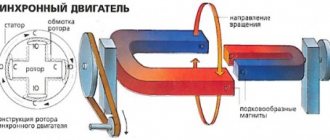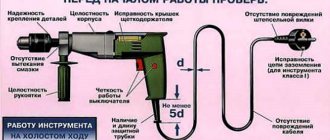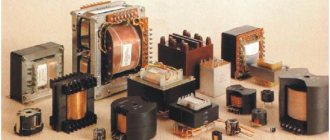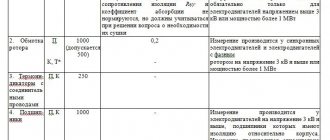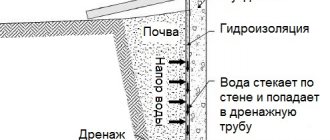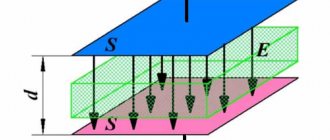Heat resistance classes of insulation and operating mode of electric motors
Since for electrical products the dominant aging factor of electrical insulating materials and insulation systems is temperature, heat resistance classes .
Currently, the most common are motors with winding insulation of class F. The winding temperature of these motors should not increase by more than 105°C at an ambient temperature of up to +40°C.
| Heat resistance classes of insulation | ||||||||
| Designation of heat resistance class | Y | A | E | B | F | H | 200 | 220 |
| Temperature, °C | 90 | 105 | 120 | 130 | 155 | 180 | 200 | 220 |
The heat resistance class of the insulation of an electrical product reflects the maximum operating temperature characteristic of this product under rated load and other conditions.
The insulation under the influence of this maximum temperature must have a heat resistance of at least the temperature corresponding to the heat resistance class of the electrical product.
The temperatures given are the actual temperature of the insulation, but not the excess temperature of the electrical product. Electrical product standards typically focus on the temperature rise, rather than the actual temperature. Factors such as design, thermal conductivity and thickness of insulation, accessibility of insulated parts, ventilation method, load characteristics, etc. should be taken into account when developing standards, establishing measurement methods and permissible temperature rise.
The basis for establishing rational temperature limits for insulation is only experience or appropriate tests (see GOST 8865–93).
The rated power always depends on the operating mode and duration of operation. The most common are electric motors with operating mode S1 , designed for continuous operation.
This mode provides for operation with a constant load, the duration of which is sufficient for the engine to operate under stable thermal conditions. Less commonly used are electric motors with a short-term operating mode S2 , which involves operation in constant load mode for a certain limited period of time, accompanied by a pause while the motor cools down to ambient temperature.
The operating modes of electric motors are determined by the IEC 34 (EN 60034) standard.
Why is it profitable to buy electric motors in?
Motor insulation class
The main factor influencing the acceleration of the aging process of insulation systems and electrical insulating materials in electromechanical products is temperature indicators. Specialists always need to evaluate the resistance of electrical insulation to temperature changes. To simplify this process, insulation heat resistance classes are provided.
Heat resistance can rightfully be considered one of the most influential qualities of materials responsible for electrical insulation. After all, based on this indicator, you can determine the maximum possible load that an electrical machine or apparatus can withstand. Many materials are not able to withstand high temperatures; an increase in degrees leads to charring, and the material itself begins to act as a conductor. In addition, all materials, when exposed to high temperatures for a long time, become more brittle, susceptible to cracking and loss of insulating properties. This process is called thermal aging. It is the heat resistance that indicates the maximum temperature a material can withstand and the effect of sudden temperature changes on it. The service life that electric motors will have, as well as the reliability of operation, are determined precisely by the heat resistance indicator. There are 7 classes of materials that differ in the heat resistance of insulation:
Class Y includes materials made from paper, textiles, cotton, cellulose, natural silk, polyamides, plastics containing organic fillers, and wood. Insulation resistance temperature - 900C. Class A - these are materials of the previous class, which are specially impregnated with an insulating composition, immersed in dielectrics such as natural resins, asphalt varnishes, oil varnishes, cellulose ether, thermoplastic compounds, transformer oil. The list can also be supplemented with varnished fabrics, insulating tapes, varnish paper, electric cardboard, getinax, textolite impregnated with wood, wood laminated plastics, certain types of synthetic films, wire insulation based on cotton fabric, silk, lavsan, enamel insulation. Temperature - 1050C. Class E includes fibers, synthetic films, varnished fabrics based on synthetic varnishes, compounds and synthetic resins. Temperature - 1200C. Class B - these are materials containing mica, fiberglass, asbestos fibers, fiberglass film, plastic without organic filler, laminated plastics. Temperature - 1300C. Class F includes the same elements, but with an inorganic support or no support at all. This also includes fiberglass film, fiberglass or asbestos insulation of types PSDT, PSD, enamel insulation based on nylon. Temperature - 1550C. Class H includes Class B materials that contain mica, fiberglass, asbestos and have an inorganic backing or are created without a backing at all. The list is complemented by elastomers made of organic silicon, insulation made of fiberglass, asbestos, and enamel. Temperature - 1800C. Class C includes glass, mica, fiberglass materials, quartz, electrical ceramics, slate, mica materials without and with fiberglass backing. Temperature - over 1800C. Most often in production you can find electric machines with insulation of classes F and B. Class A insulation is practically not produced, and class E can only be used in machines with low power. For machines required to operate under harsh conditions, Class A insulation is suitable. The use of materials that can withstand high temperatures allows, for example, an asynchronous motor to be made more compact.
The greatest heat resistance is found in mica and fiberglass materials, which contain organic silicon binders, as well as impregnating compounds. However, despite the study of heat resistance parameters, it is extremely difficult to determine what maximum temperature the hottest part in the gearmotor can withstand. Temperature standards are the lowest acceptable limits. The degree of insulation also depends on the ambient temperature.
The temperature of electric motors during their repair or operation is determined using expansion thermometers, thermocouples, and thermistors. With their help, you can measure not only the temperature of the winding, but other elements of the engine. An indirect method can also be used - in this case, resistance is measured at a constant current level. The electric motor may fail if the operating current is increased and the windings overheat. To prevent this from happening, the heating temperature is checked. The insulation class determines the permissible temperature. Also, the reason may lie in deteriorating cooling conditions: pay attention to the serviceability of the fan, dirt in the engine and external objects on it. Overload can lead to damage to the electric motor: along with an increase in current, the temperature increases quadratically. Long-term overload may cause damage to the winding insulation.
Subscribe to the newsletter
The operating temperature of the electric motor (hereinafter EM) is determined primarily by the heat resistance class of the winding insulation. And its control is very important. If the motor overheats, it may be damaged.
Heat resistance classes of winding insulation
Windings are the least heat-resistant part of the electric motor design. Therefore, the operating temperature limit of the entire device is determined precisely by the temperature at which they burn out.
The following classes of heat resistance of winding insulation are distinguished:
- U (maximum temperature - 90 degrees Celsius). The windings are made of paper or natural fabrics without additional insulating impregnation;
- A (maximum temperature - 105 degrees Celsius). Windings made of paper or natural fabrics with additional insulating impregnation;
- E (maximum temperature – 120 degrees Celsius). Windings made of organic film of synthetic origin;
- B (maximum temperature - 130 degrees Celsius). Windings made of fiberglass or mineral compounds;
- F (maximum temperature - 155 degrees Celsius). Windings made of fiberglass or mineral compounds with synthetic binder impregnation;
- H (maximum temperature - 180 degrees Celsius). Windings made of fiberglass or mineral compounds with silicone binder impregnation;
- C (maximum temperature from 180 degrees Celsius). Windings made of heat-resistant materials with or without inorganic binder impregnation.
If the operating temperature of an asynchronous motor is too low, then it can be transferred to a higher heat resistance class only with a major overhaul and replacement of the windings.
Operating temperature of electric motor bearings
In addition to the windings, the electric motor bearings are also very sensitive to operating temperature conditions. The established heating standards are as follows:
- Rolling bearings – 95-100 degrees Celsius;
- Sliding bearings – 80-85 degrees Celsius;
- Steel parts of the commutator and slip rings – 105-110 degrees Celsius.
When critical values of the bearing temperature are reached, it is necessary to either reduce the load on the motor used or organize a cooling system.
Temperature operating conditions of electric motors
Normal values of ambient temperature at which the electric motor operates with rated power are determined by the climatic design of the electric motor. Thus, machines with versions U1 and HL1 are designed for operation at ambient temperatures up to +40 degrees Celsius, U3 and T2 - up to +45 degrees Celsius, T1 - up to +50 degrees Celsius. If the ambient temperature exceeds this parameter and it is not possible to organize cooling, then it is necessary to reduce the load on the electric motor used.
To control the temperature, you should monitor the voltage in the supply network. When it decreases to 95% of the nominal value and below, an increased current is supplied to the electric motor, which leads to overheating of the device. A similar phenomenon is observed when the voltage increases to 110% or higher of the nominal value, since vortex flows lead to heating of the stator.
According to statistics, the service life of insulation when the temperature rises 8 degrees above the permissible norm reduces its operational period by half. Therefore, to maintain the operability of the machine, it is worth finding out the permissible operating temperature, avoiding overheating and exceeding (or reducing) current loads.
HEAT RESISTANCE OF DIELECTRICS. HEAT RESISTANCE CLASSES
Heat resistance
– this is the ability of electrical insulation to withstand high temperatures for a long time without unacceptable deterioration of its properties and characteristics.
The quality of insulation when exposed to elevated temperatures is assessed:
- for inorganic dielectrics by changing the values (in the direction of decrease) and (in the direction of increase);
- for organic dielectrics by changing the values of the tensile strength and bending strength, and in addition, by the degree of immersion of the needle into the insulating material under pressure when heated and by changing the values and.
The degree of heat resistance of an insulating material can be assessed by the values of its flash point and ignition temperature.
Flash point
- This is the temperature at which an insulating material ignites in air vapor when a small flame is brought to it.
Flash point
- a temperature that is greater than the flash point and at which the insulating material ignites when a flame is brought to it.
During operation, these temperatures should be as high as possible.
In accordance with the recommendations of the IEC (International Electrotechnical Commission), insulating materials are divided into heat resistance classes
(YE – pure organic insulating materials, BH – combined insulating materials, C – inorganic insulating materials).
Table 1 – Heat resistance classes of dielectrics
| Heat resistance class | Y | A | E | B | F | H | C |
| Permissible operating temperature | >180 |
Heat resistance class Y includes materials based on paper or fabric (yarn, fabric, tape, paper, cardboard, wood) that are not impregnated or immersed in liquid insulating material.
Heat resistance class A includes the same materials, but provided that they are impregnated with liquid insulating material or immersed in it (a wire with cotton insulation in a varnish-impregnated winding of an electrical machine or in the winding of an oil-filled transformer immersed in electrical insulating oil; varnished fabric on cotton or silk base and oil or bitumen-oil varnishes; varnish paper on the same varnishes).
Heat resistance class E includes materials based on plastics using organic binders based on various resins, compounds, varnishes, etc. (getinax, textolite, press powders filled with wood flour, polyethylene terephthalate films, epoxy, polyester and polyurethane resins and compounds, insulation of enameled wires on polyurethane and epoxy varnishes, etc.).
Heat resistance class B includes materials of inorganic origin using organic binders (chip mica, asbestos and fiberglass materials, micanites (including those with a paper or fabric organic backing), glass laminate fabrics, fiberglass laminates on phenol-formaldehyde thermosetting resins, epoxy compounds with inorganic fillers).
Heat resistance class F includes inorganic materials using organic binders of increased heat resistance (fiberglass without a substrate or with an inorganic substrate, using organic binders and impregnating materials of increased heat resistance: epoxy, thermosetting polyester, organosilicon).
Heat resistance class H includes inorganic materials in which organosilicon resins of particularly high heat resistance are used as a binder.
Heat resistance class C includes inorganic materials that do not contain adhesive or impregnating organic binders (asbestos, glass, mica, fiberglass, quartz, micalex, heat-resistant micanites, unimpregnated asbestos cement, etc.). The exceptions are materials of organic origin: fluoroplastic-4 (polytetrafluoroethylene) and materials based on polyimides (fibers, films, insulation of enameled wires, etc.).
